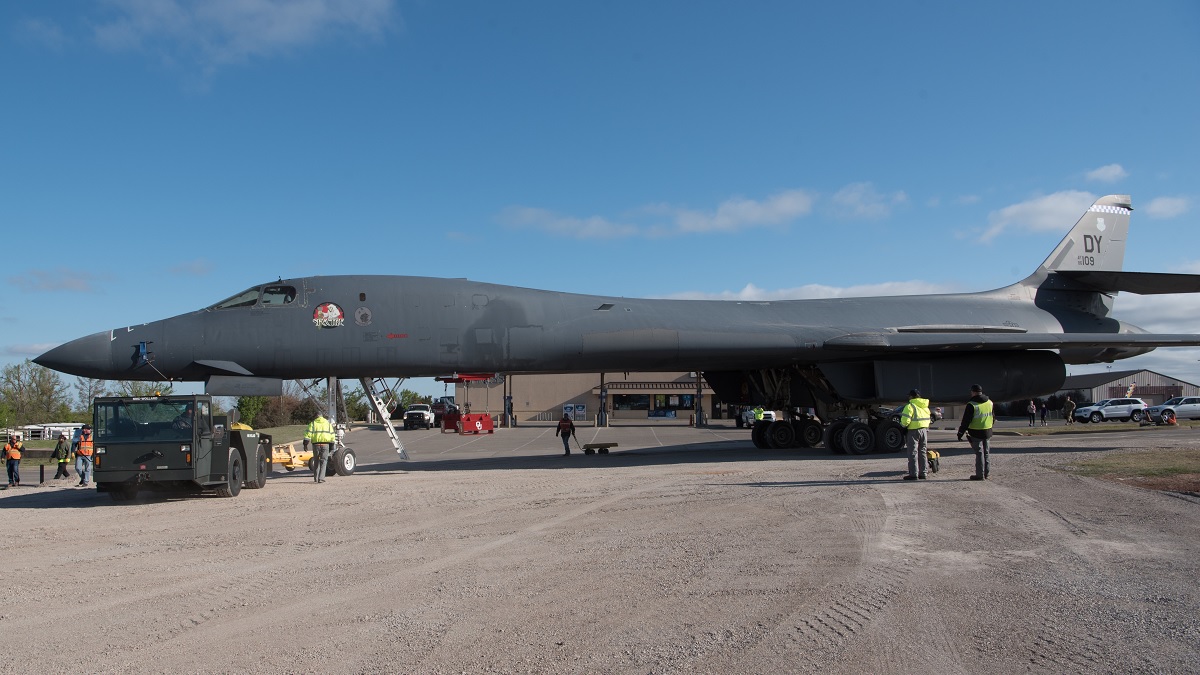The B-1B Lancer 86-109, “Spectre,” which had an in-flight fire in one of its engines and a subsequent ejection seat failure has now been retired to Tinker Air Force Base.
The B-1B Lancer 86-109, “Spectre,” that had an in-flight fire in one of its engines and a subsequent ejection seat failure has now been retired to Tinker Air Force Base (AFB).
As explained by Paul Shirk, 72nd Air Base Wing Public Affairs, in the article B-1B “Spectre” finds retirement job with 76th EDMX, 86-109 left the flight line for the last time Apr. 10, 2021, as it was retired and towed to an Aircraft Battle Damage Repair training pad at the 76th Maintenance Group’s Expeditionary Depot Maintenance Flight on the south side of the base.
First Lt. Mason Shaw, EDMX commander, said the move required many coordinating parties including the Navy’s Strategic Communication Wing ONE, B-1 Systems Program Office, 72nd Security Forces Squadron, Public Affairs, Oklahoma Gas & Electric, the 567th and 569th Aircraft Maintenance Squadrons, Civil Engineering, Alutiiq and 76th Aircraft Maintenance Group Engineering.
The Lancer joins two other aircraft serving as maintenance trainers: a B-52 Stratofortress and a C-135 Stratolifter, “Speckled Trout,” which has the same airframe as the KC-135 Stratotanker.
“This aircraft will be important to train for advanced repair techniques and as an engineering test aid for form, fit, and function of future modifications and structural repairs,” said Col Greg Lowe, 76th Aircraft Maintenance Group commander.

Preparing the B-1B for its retirement job required removing the engines, certain avionics, and other equipment not essential for its new mission.
For the aircraft to safely leave the flight line and travel to its new home, two temporary gravel ramps were constructed. A number of road signs, poles, and a power line had to be temporarily removed to give the aircraft an unobstructed path.
The B-1B’s signature swing wings were kept in their swept position to keep the aircraft’s footprint as narrow as possible. Two counterweights were suspended from the forward section of the aircraft, each weighing 2,640 pounds.
The half-mile trip lasted approximately 20 minutes. The following Monday, “Spectre’s” wings were manually brought forward one at a time using only a cordless drill, which took about 5 minutes per wing. In flight, moving both wings would have taken about 10 seconds.
“Spectre” had an unlikely path to its new home. After recording 12,136 flying hours, it made an emergency landing on May 1, 2018, in Midland after the number 4 engine had a fire in mid-air. As reported by Alert5, the crew had exhausted all options to put out the fire and choose to eject. However, the first person to pull the ejection handle failed to egress from the aircraft due to a failure in the ejection seat. The crew commander then made a decision to land the aircraft instead, with a fire on board and a missing hatch.

It was later flown by the 10th Flight Test Squadron with just three functioning engines to Tinker Air Force Base, Oklahoma, on Oct. 26, 2018, for depot maintenance. The damaged engine nacelle was replaced and the ejection seat was repaired, the Integrated Battle Station modification and a full Programmed Depot Maintenance overhaul was also carried out. Despite all the work done, the service decided to retire the aircraft.
“The artisans of the Oklahoma City Air Logistics Complex repaired the damaged nacelle, replaced the ejection system, and performed both the Integrated Battle Station modification and a full Programmed Depot Maintenance overhaul,” Lowe said. “Despite all of the work, the aircraft was selected for retirement, but it will be a welcome addition to the ABDR program.”
As already reported, last February the US Air Force (USAF) began divesting 17 B-1B bombers from its current fleet as authorized by the National Defense Authorization Act.
The service said this action will not affect the service’s lethality or any associated maintenance manpower. It will allow officials to focus maintenance and depot-level manpower on the remaining aircraft, increasing readiness and paving the way for the bomber fleet modernization ready to meet future challenges.
The 17 B-1B aircraft will be retired from the current fleet of 62 B-1s, leaving 45 in the active fleet. Of the 17 B-1 aircraft, four will be required to remain in a reclaimable condition that is consistent with Type 2000 recallable storage.
Photo by Greg L. Davis and Paul Shirk / U.S. Air Force

